A Performance Evaluation of Dynamical Downscaling of Precipitation over Northern California
Abstract
:1. Introduction
2. Study Area and Methodology
2.1. Study Area
2.2. Methodology
3. Results and Discussion
3.1. Evaluation at Point Scale
3.2. Evaluation at Watershed Scale
3.3. Evaluation of Spatial Characteristics over the Whole Modeling Domain at Regional Scale
4. Summary and Conclusions
Acknowledgments
Author Contributions
Conflicts of Interest
References
- Kalnay, E.; Kanamitsu, M.; Kistler, R.; Collins, W.; Deaven, D.; Gandin, L.; Iredell, M.; Saha, S.; White, G.; Woollen, J.; et al. The NCEP/NCAR 40-Year Reanalysis Project. Bull. Am. Meteorol. Soc. 1996, 77, 437–471. [Google Scholar] [CrossRef]
- Kavvas, M.L.; Kure, S.; Chen, Z.Q.; Ohara, N.; Jang, S. WEHY-HCM for Modeling Interactive Atmospheric-Hydrologic Processes at Watershed Scale. I: Model Description. J. Hydrol. Eng. 2013, 18, 1262–1271. [Google Scholar] [CrossRef]
- Kure, S.; Jang, S.; Ohara, N.; Kavvas, M.L.; Chen, Z.Q. WEHY-HCM for Modeling Interactive Atmospheric-Hydrologic Processes at Watershed Scale. II: Model Application to Ungauged and Sparsely Gauged Watersheds. J. Hydrol. Eng. 2013, 18, 1272–1281. [Google Scholar] [CrossRef]
- Grotch, S.L.; MacCracken, M.C. The Use of General Circulation Models to Predict Regional Climatic Change. J. Clim. 1991, 4, 286–303. [Google Scholar] [CrossRef]
- Fowler, H.J.; Blenkinsop, S.; Tebaldi, C. Linking climate change modelling to impacts studies: Recent advances in downscaling techniques for hydrological modelling. Int. J. Climatol. 2007, 27, 1547–1578. [Google Scholar] [CrossRef]
- Christensen, J.H.; Christensen, O.B. Climate modelling: Severe summertime flooding in Europe. Nature 2003, 421, 805–806. [Google Scholar] [CrossRef] [PubMed]
- Maraun, D.; Wetterhall, F.; Ireson, A.M.; Chandler, R.E.; Kendon, E.J.; Widmann, M.; Brienen, S.; Rust, H.W.; Sauter, T.; Themeßl, M.; et al. Precipitation downscaling under climate change: Recent developments to bridge the gap between dynamical models and the end user. Rev. Geophys. 2010, 48, RG3003. [Google Scholar] [CrossRef]
- Jang, S.; Kavvas, M.L. Downscaling global climate simulations to regional scales: Statistical downscaling versus dynamical downscaling. J. Hydrol. Eng. 2015, 20. [Google Scholar] [CrossRef]
- Kavvas, M.L.; Chen, Z.Q.; Tan, L.; Soong, S.-T.; Terakawa, A.; Yoshitani, J.; Fukami, K. A regional-scale land surface parameterization based on areally-averaged hydrological conservation equations. Hydrol. Sci. J. 1998, 43, 611–631. [Google Scholar] [CrossRef]
- Shrestha, R.; Tachikawa, Y.; Takara, K. Input data resolution analysis for distributed hydrological modeling. J. Hydrol. 2006, 319, 36–50. [Google Scholar] [CrossRef]
- Haltas, I.; Kavvas, M.L. Scale Invariance and Self-Similarity in Hydrologic Processes in Space and Time. J. Hydrol. Eng. 2011, 16, 51–63. [Google Scholar] [CrossRef]
- Diaz-Nieto, J.; Wilby, R.L. A comparison of statistical downscaling and climate change factor methods: Impacts on low flows in the River Thames, United Kingdom. Clim. Chang. 2005, 69, 245–268. [Google Scholar] [CrossRef]
- Mearns, L.O.; Giorgi, F.; Whetton, P.; Pabon, D.; Hulme, M.; Lal, M. Guideline for Use of Climate Scenarios Developed from Regional Climate Model Experiments; Data Distribution Centre of the Intergovernmental Panel on Climate Change Task Group on Data and Scenario Support for Impact and Climate Analysis: Geneva, Switzerland, 2003. [Google Scholar]
- Jones, R.G.; Murphy, J.M.; Noguer, M. Simulation of climate change over europe using a nested regional-climate model. I: Assessment of control climate, including sensitivity to location of lateral boundaries. Q. J. R. Meteorol. Soc. 1995, 121, 1413–1449. [Google Scholar] [CrossRef]
- Frei, C.; Christensen, J.H.; Déqué, M.; Jacob, D.; Jones, R.G.; Vidale, P.L. Daily precipitation statistics in regional climate models: Evaluation and intercomparison for the European Alps. J. Geophys. Res. 2003, 108. [Google Scholar] [CrossRef]
- Christensen, J.H.; Christensen, O.B. A summary of the PRUDENCE model projections of changes in European climate by the end of this century. Clim. Chang. 2007, 81, 7–30. [Google Scholar] [CrossRef]
- Fowler, H.J.; Kilsby, C.G.; O’Connell, P.E.; Burton, A. A weather-type conditioned multi-site stochastic rainfall model for the generation of scenarios of climatic variability and change. J. Hydrol. 2005, 308, 50–66. [Google Scholar] [CrossRef]
- Frei, C.; Schöll, R.; Fukutome, S.; Schmidli, J.; Vidale, P.L. Future change of precipitation extremes in Europe: Intercomparison of scenarios from regional climate models. J. Geophys. Res. 2006, 111, D06105. [Google Scholar] [CrossRef]
- Murphy, J. An Evaluation of Statistical and Dynamical Techniques for Downscaling Local Climate. J. Clim. 1999, 12, 2256–2284. [Google Scholar] [CrossRef]
- Leung, L.R.; Qian, Y.; Bian, X. Hydroclimate of the Western United States Based on Observations and Regional Climate Simulation of 1981–2000. Part I: Seasonal Statistics. J. Clim. 2003, 16, 1892–1911. [Google Scholar] [CrossRef]
- Leung, L.R.; Qian, Y.; Bian, X.; Hunt, A. Hydroclimate of the Western United States Based on Observations and Regional Climate Simulation of 1981–2000. Part II: Mesoscale ENSO Anomalies. J. Clim. 2003, 16, 1912–1928. [Google Scholar] [CrossRef]
- Leung, L.R.; Qian, Y. Atmospheric rivers induced heavy precipitation and flooding in the western U.S. simulated by the WRF regional climate model. Geophys. Res. Lett. 2009, 36. [Google Scholar] [CrossRef]
- Rauscher, S.A.; Coppola, E.; Piani, C.; Giorgi, F. Resolution effects on regional climate model simulations of seasonal precipitation over Europe. Clim. Dyn. 2010, 35, 685–711. [Google Scholar] [CrossRef]
- Liu, J.; Bray, M.; Han, D. Sensitivity of the Weather Research and Forecasting (WRF) model to downscaling ratios and storm types in rainfall simulation. Hydrol. Process. 2012, 26, 3012–3031. [Google Scholar] [CrossRef]
- Leung, L.R.; Qian, Y.; Bian, X.; Washington, W.M.; Han, J.; Roads, J.O. Mid-Century Ensemble Regional Climate Change Scenarios for the Western United States. Clim. Chang. 2004, 62, 75–113. [Google Scholar] [CrossRef]
- Salathé, E.P.; Steed, R.; Mass, C.F.; Zahn, P.H. A High-Resolution Climate Model for the U.S. Pacific Northwest: Mesoscale Feedbacks and Local Responses to Climate Change. J. Clim. 2008, 21, 5708–5726. [Google Scholar] [CrossRef]
- Salathé, E.P.; Leung, L.R.; Qian, Y.; Zhang, Y. Regional climate model projections for the State of Washington. Clim. Chang. 2010, 102, 51–75. [Google Scholar] [CrossRef]
- Gao, Y.; Leung, L.R.; Lu, J.; Liu, Y.; Huang, M.; Qian, Y. Robust spring drying in the southwestern U.S. and seasonal migration of wet/dry patterns in a warmer climate. Geophys. Res. Lett. 2014, 41, 1745–1751. [Google Scholar] [CrossRef]
- Caldwell, P.; Chin, H.-N.S.; Bader, D.C.; Bala, G. Evaluation of a WRF dynamical downscaling simulation over California. Clim. Chang. 2009, 95, 499–521. [Google Scholar] [CrossRef]
- Gao, Y.; Fu, J.S.; Drake, J.B.; Liu, Y.; Lamarque, J.-F. Projected changes of extreme weather events in the eastern United States based on a high resolution climate modeling system. Environ. Res. Lett. 2012, 7, 044025. [Google Scholar] [CrossRef]
- Bachner, S.; Kapala, A.; Simmer, C. Evaluation of daily precipitation characteristics in the CLM and their sensitivity to parameterizations. Meteorol. Z. 2008, 17, 407–419. [Google Scholar] [CrossRef]
- Fowler, H.J.; Ekström, M. Multi-model ensemble estimates of climate change impacts on UK seasonal precipitation extremes. Int. J. Climatol. 2009, 29, 385–416. [Google Scholar] [CrossRef]
- Tatsumi, K.; Yamashiki, Y.; Takara, K. Effect of uncertainty in temperature and precipitation inputs and spatial resolution on the crop model. Hydrol. Res. Lett. 2011, 5, 52–57. [Google Scholar] [CrossRef]
- Nakaegawa, T.; Nakakita, E. Comment on “Effect of uncertainty in temperature and precipitation inputs and spatial resolution on the crop model” by Kenichi Tatsumi, Yosuke Yamashiki and Kaoru Takara. Hydrol. Res. Lett. 2012, 6, 13–14. [Google Scholar] [CrossRef]
- California Data Exchange Center (CDEC). Available online: http://cdec.water.ca.gov/ (accessed on 10 August 2017).
- National Elevation Dataset (NED). Available online: https://nationalmap.gov/elevation.html (accessed on 10 August 2017).
- Global Land Cover Characteristics (GLCC) Data Base Version 2.0. Available online: https://lta.cr.usgs.gov/glcc/globdoc2_0 (accessed on 10 August 2017).
- Grell, G.A.; Dudhia, J.; Stauffer, D. A Description of the Fifth-Generation Penn State/NCAR Mesoscale Model (MM5); Mesoscale and Microscale Meteorology Division, National Center for Atmospheric Research: Boulder, CO, USA, 1994; p. 121. [Google Scholar]
- NCAR/NCEP Reanalysis I Data. Available online: http://rda.ucar.edu/datasets/ds090.1/ (accessed on 10 August 2017).
- Giorgi, F.; Gutowski, W.J. Regional downscaling and the CORDEX initiative. Ann. Rev. Environ. Resour. 2015, 40, 467–490. [Google Scholar] [CrossRef]
- Grubišić, V.; Vellore, R.K.; Huggins, A.W. Quantitative Precipitation Forecasting of Wintertime Storms in the Sierra Nevada: Sensitivity to the Microphysical Parameterization and Horizontal Resolution. Mon. Weather Rev. 2005, 133, 2834–2859. [Google Scholar] [CrossRef]
- Reeves, H.D.; Lin, Y.-L.; Rotunno, R. Dynamic Forcing and Mesoscale Variability of Heavy Precipitation Events over the Sierra Nevada Mountains. Mon. Weather Rev. 2008, 136, 62–77. [Google Scholar] [CrossRef]
- Ohara, N.; Kavvas, M.L.; Kure, S.; Chen, Z.Q.; Jang, S.; Tan, E. Physically Based Estimation of Maximum Precipitation over American River Watershed, California. J. Hydrol. Eng. 2011, 16, 351–361. [Google Scholar] [CrossRef]
- Ishida, K.; Kavvas, M.L.; Jang, S.; Chen, Z.Q.; Ohara, N.; Anderson, M.L. Physically Based Estimation of Maximum Precipitation over Three Watersheds in Northern California: Atmospheric Boundary Condition Shifting. J. Hydrol. Eng. 2015, 20, 04014052. [Google Scholar] [CrossRef]
- Ishida, K.; Kavvas, M.L.; Jang, S. Comparison of Performance on Watershed-Scale Precipitation between WRF and MM5. Am. Soc. Civ. Eng. 2015, 989–993. [Google Scholar] [CrossRef]
- Skamarock, W.C.; Klemp, J.B.; Dudhia, J.; Gill, D.O.; Barker, D.M.; Wang, W.; Powers, J.G. A Description of the Advanced Research WRF Version 2; Mesoscale and Microscale Meteorology Division, National Center for Atmospheric Research: Boulder, CO, USA, 2005; p. 88. [Google Scholar]
- PRISM Preciptation Data. Available online: http://prism.oregonstate.edu (accessed on 10 August 2017).
- NCEP/EMC U.S. Gridded Precipitation. Available online: http://data.eol.ucar.edu/ (accessed on 10 August 2017).
- Daly, C.; Halbleib, M.; Smith, J.I.; Gibson, W.P.; Doggett, M.K.; Taylor, G.H.; Curtis, J.; Pasteris, P.P. Physically sensitive mapping of climatological temperature and precipitation across the conterminous United States. Int. J. Climatol. 2008, 28, 2031–2064. [Google Scholar] [CrossRef]
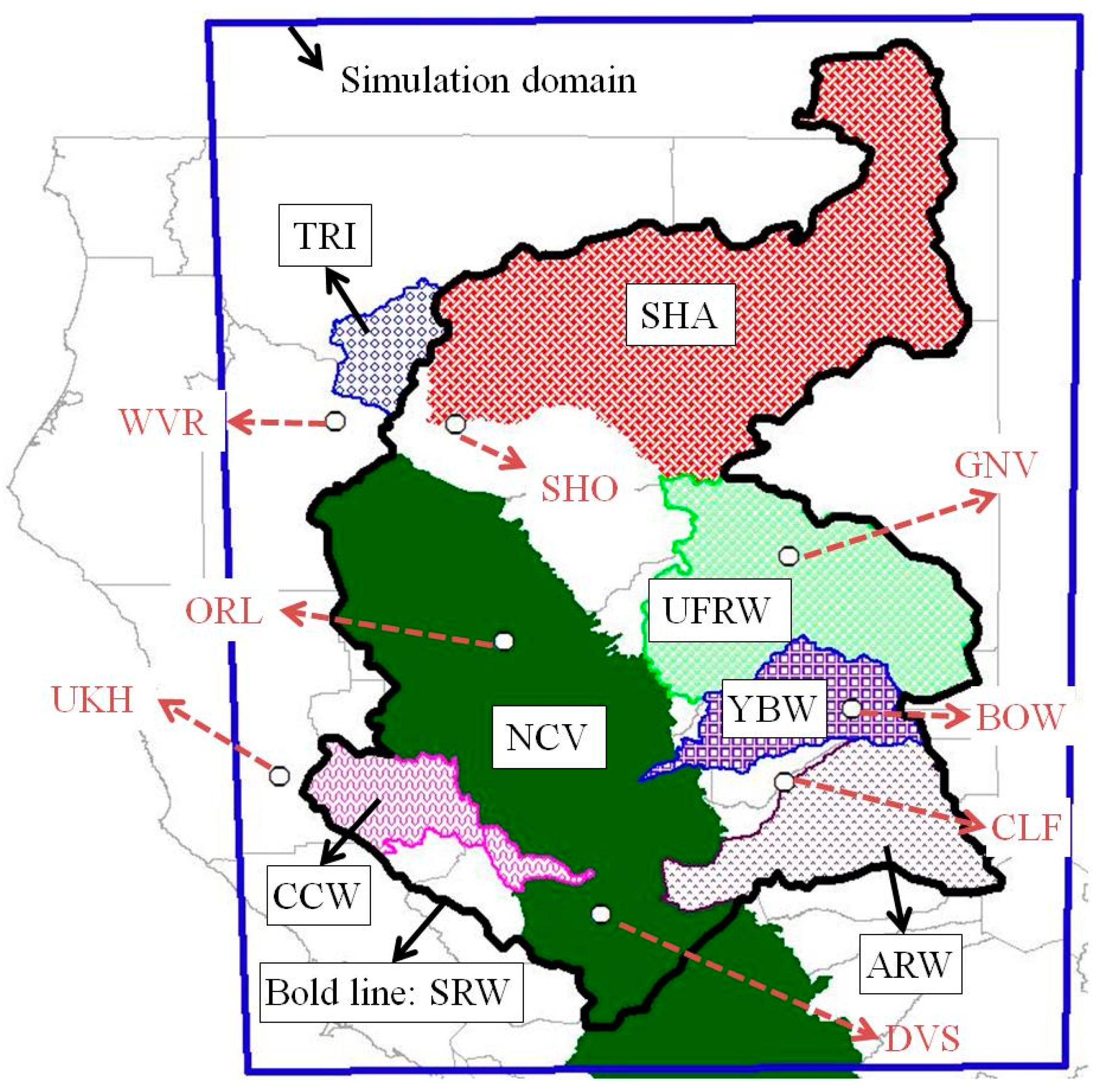

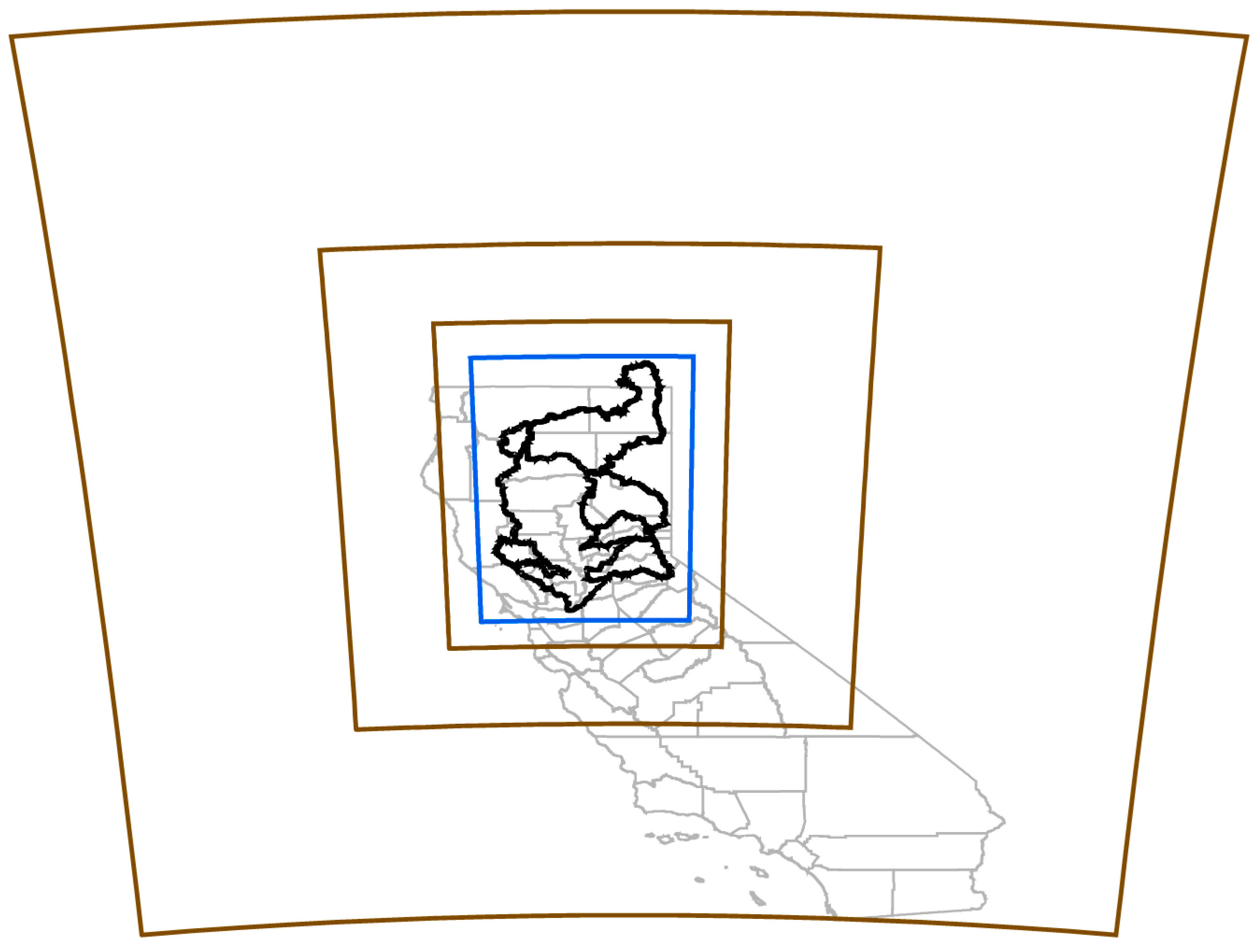

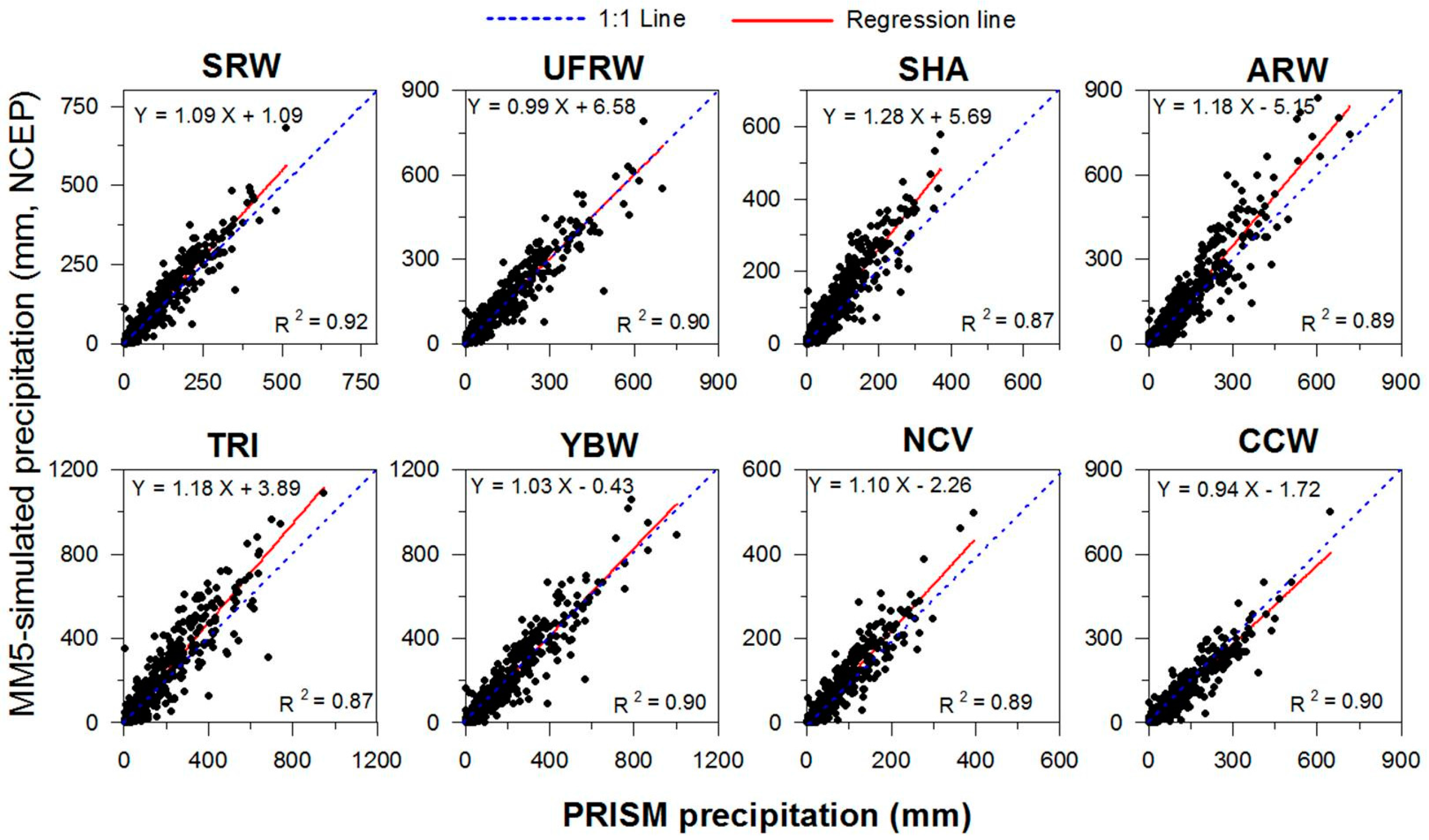
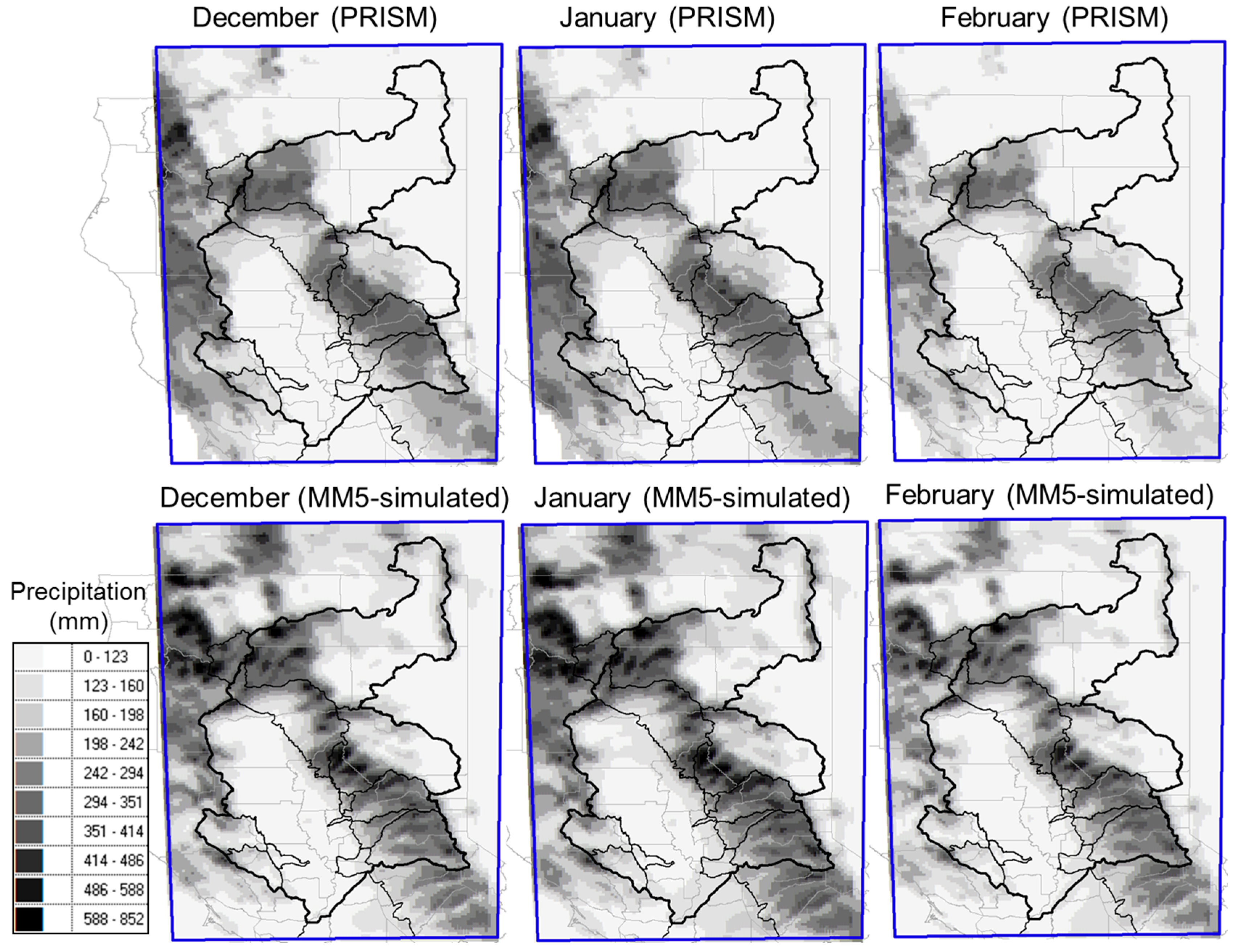
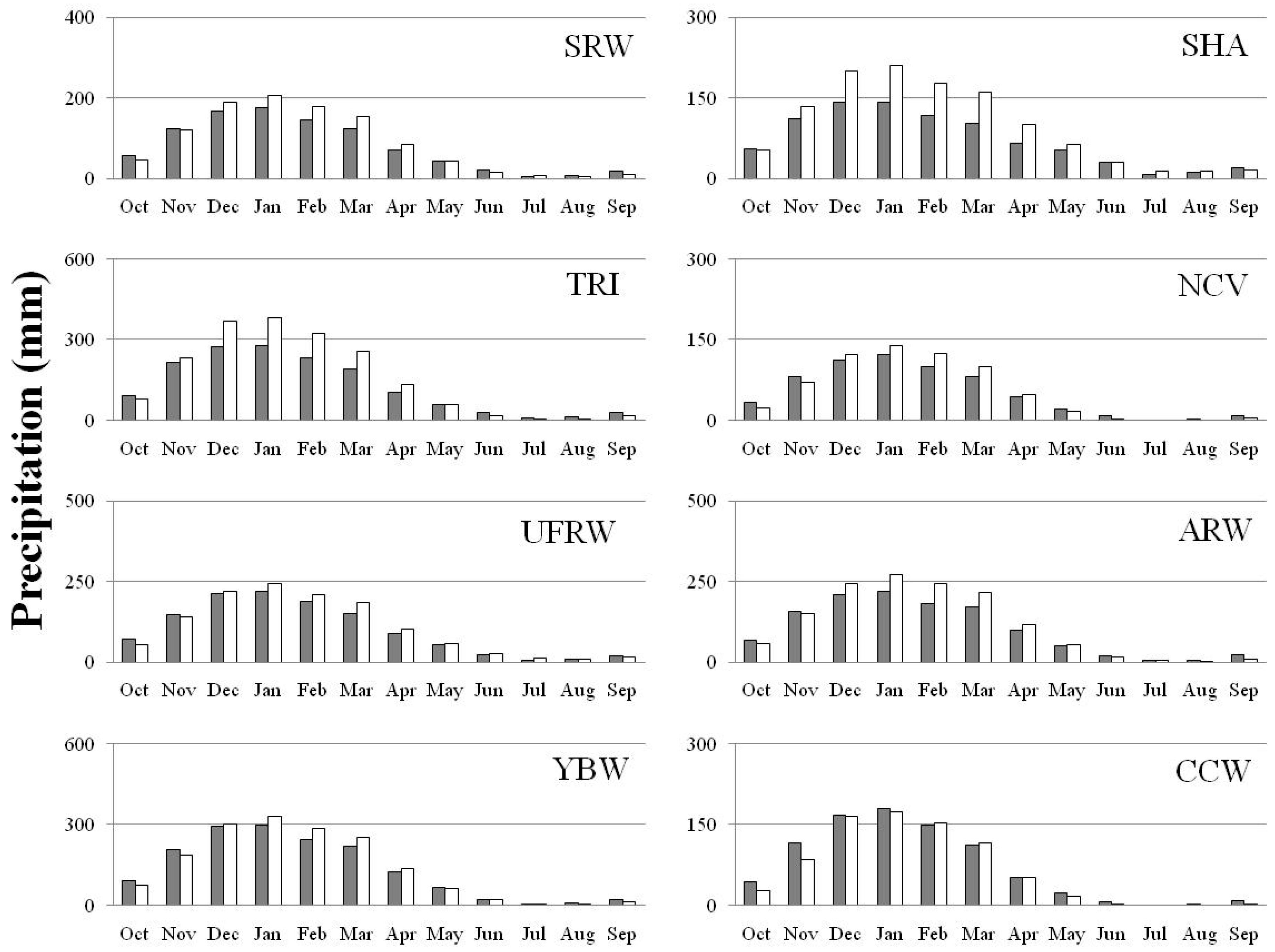
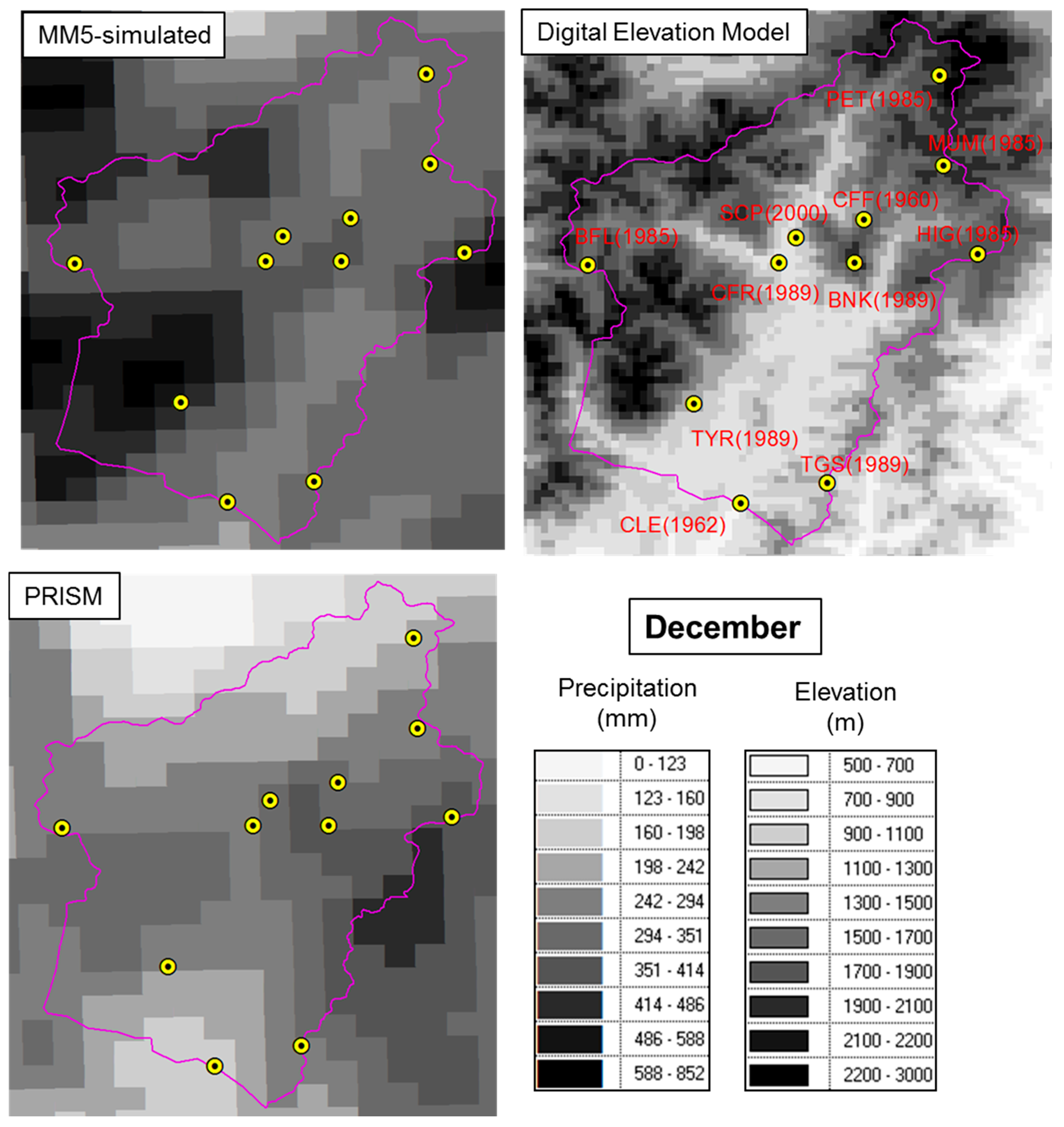

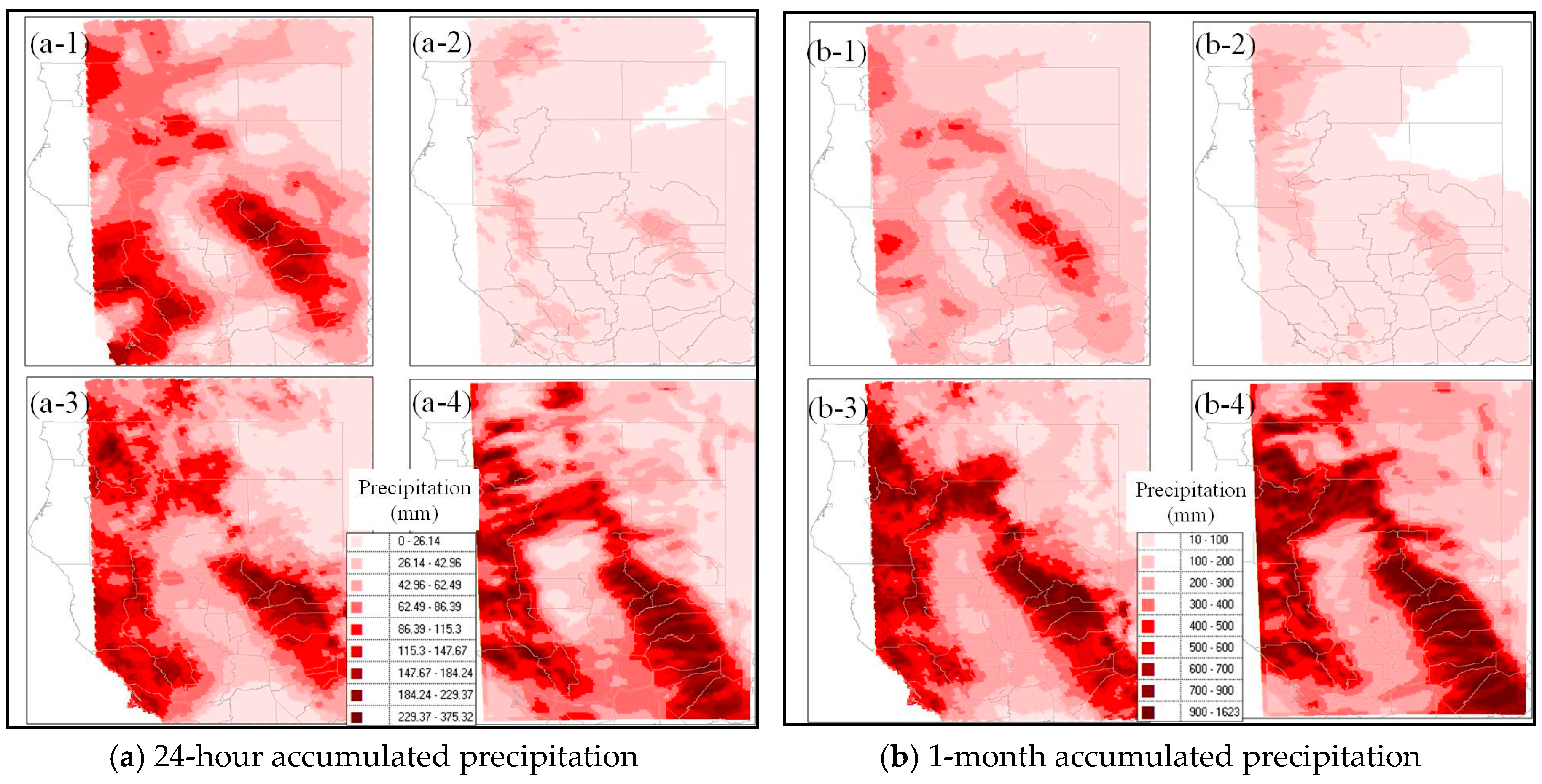
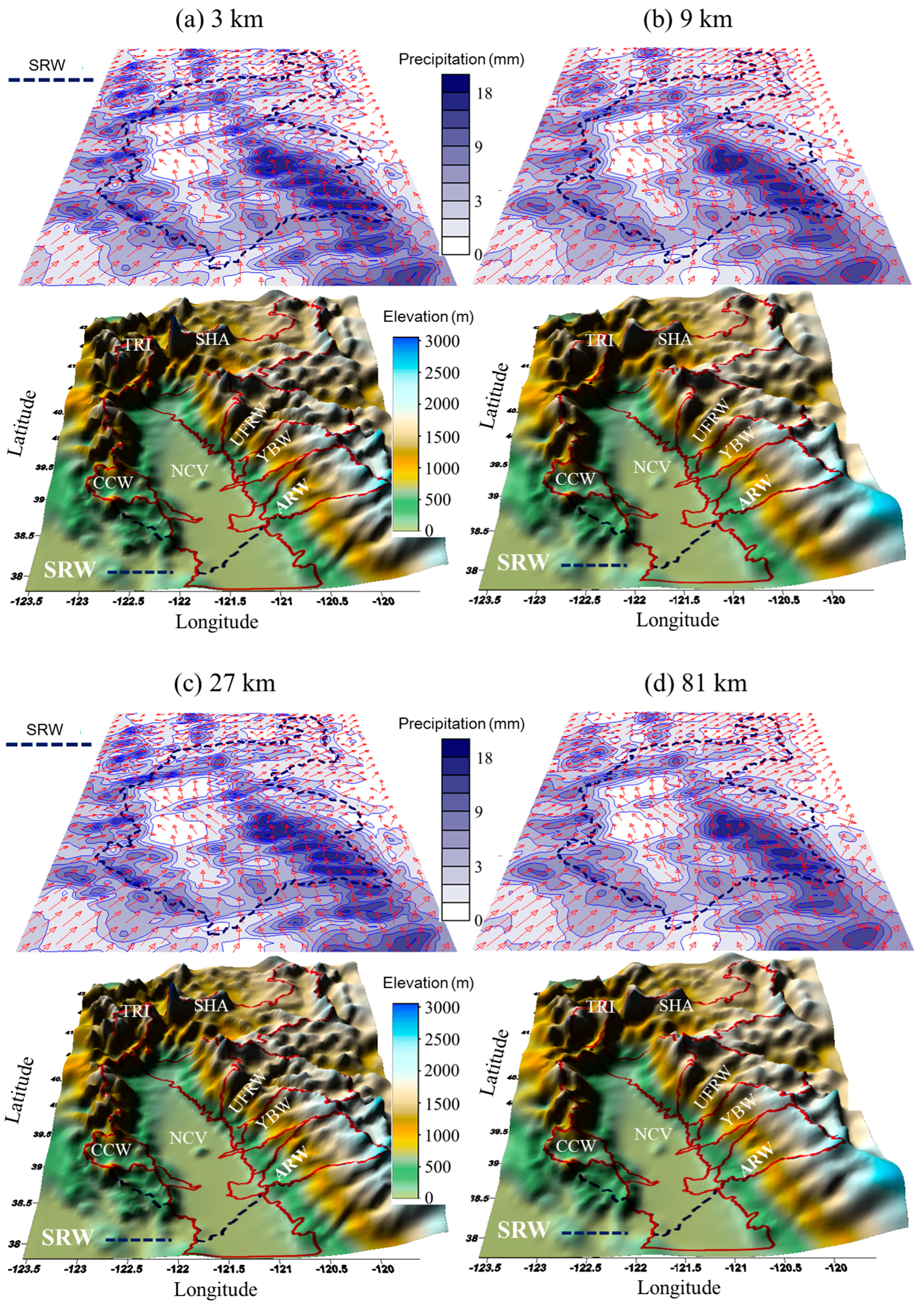
| Watershed | Ground Observationa | |||||
|---|---|---|---|---|---|---|
| ID | Basin Name | Drainage Area (km2) | Mean Elevation (m) | ID | Station Name | Elevation (m) |
| SRW | Sacramento River | 71,721 | 921 | SHO | Shasta dam | 328 |
| SHA | Shasta dam | 19,818 | 1419 | WVR | Weaverville RS | 625 |
| TRI | Trinity dam | 1701 | 1417 | GNV | Greenville RS | 1088 |
| NCV | Northern Central Valley | 27,351 | 197 | BOW | Bowman | 1641 |
| UFRW | Upper Feather River | 9225 | 1532 | CLF | Colfax | 732 |
| ARW | American River | 5535 | 1149 | ORL | Orland | 77 |
| YBW | Yuba River | 3528 | 1202 | UKH | Ukiah | 193 |
| CCW | Cache Creek | 2970 | 535 | DVS | Davis 2WSW | 18 |
| Watershed | Model | Mean (mm) | STDEV (mm) | RMSE (mm) | R2 | Nash-Sutcliffe Efficiency |
|---|---|---|---|---|---|---|
| SRW | PRISM | 79.63 | 91.57 | |||
| MM5-simulated | 88.20 | 104.70 | 32.72 | 0.92 | 0.87 | |
| SHA | PRISM | 71.56 | 72.84 | |||
| MM5-simulated | 97.60 | 100.22 | 48.94 | 0.87 | 0.55 | |
| TRI | PRISM | 128.91 | 153.14 | |||
| MM5-simulated | 155.57 | 193.10 | 79.07 | 0.87 | 0.73 | |
| NCV | PRISM | 50.92 | 63.78 | |||
| MM5-simulated | 53.66 | 74.11 | 25.15 | 0.89 | 0.83 | |
| UFRW | PRISM | 100.52 | 120.76 | |||
| MM5-simulated | 106.17 | 125.79 | 39.29 | 0.90 | 0.89 | |
| ARW | PRISM | 101.59 | 121.49 | |||
| MM5-simulated | 114.85 | 152.47 | 57.54 | 0.89 | 0.78 | |
| YBW | PRISM | 136.31 | 165.91 | |||
| MM5-simulated | 140.50 | 180.41 | 56.27 | 0.90 | 0.88 | |
| CCW | PRISM | 72.16 | 97.28 | |||
| MM5-simulated | 65.77 | 95.75 | 31.18 | 0.90 | 0.90 |
© 2017 by the authors. Licensee MDPI, Basel, Switzerland. This article is an open access article distributed under the terms and conditions of the Creative Commons Attribution (CC BY) license (http://creativecommons.org/licenses/by/4.0/).
Share and Cite
Jang, S.; Kavvas, M.L.; Ishida, K.; Trinh, T.; Ohara, N.; Kure, S.; Chen, Z.Q.; Anderson, M.L.; Matanga, G.; Carr, K.J. A Performance Evaluation of Dynamical Downscaling of Precipitation over Northern California. Sustainability 2017, 9, 1457. https://doi.org/10.3390/su9081457
Jang S, Kavvas ML, Ishida K, Trinh T, Ohara N, Kure S, Chen ZQ, Anderson ML, Matanga G, Carr KJ. A Performance Evaluation of Dynamical Downscaling of Precipitation over Northern California. Sustainability. 2017; 9(8):1457. https://doi.org/10.3390/su9081457
Chicago/Turabian StyleJang, Suhyung, M. Levent Kavvas, Kei Ishida, Toan Trinh, Noriaki Ohara, Shuichi Kure, Z. Q. Chen, Michael L. Anderson, G. Matanga, and Kara J. Carr. 2017. "A Performance Evaluation of Dynamical Downscaling of Precipitation over Northern California" Sustainability 9, no. 8: 1457. https://doi.org/10.3390/su9081457




